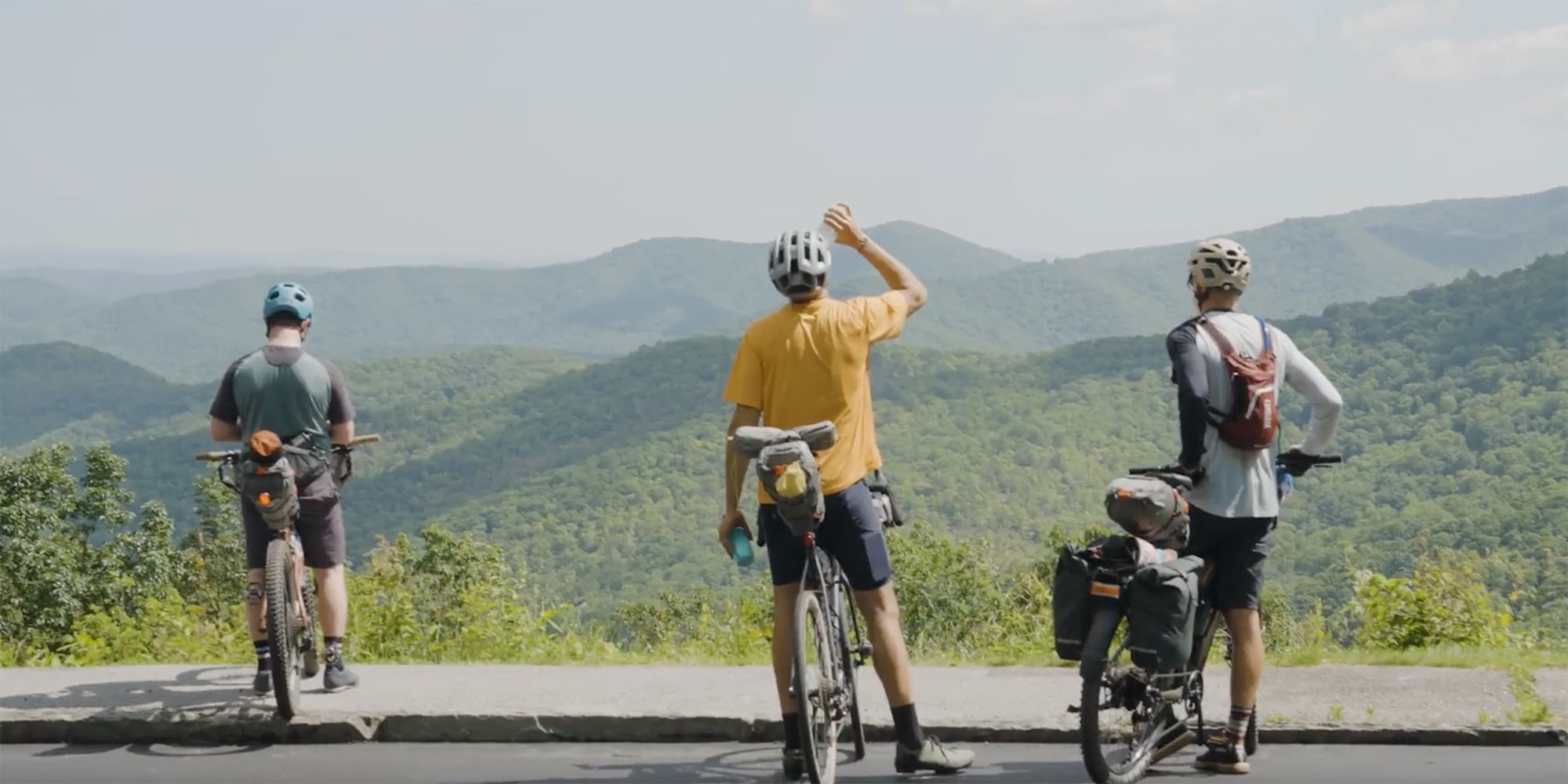The gravel road we’re pedaling is straight out of one of my nightmares. It’s a twisty thing, carving its way through the lush hardwoods of the Southern Appalachians. With every bend in the road, the grade gets just a little bit steeper. There is no flat. There is no downhill. Only endless climbing through the South’s muggy heat. It’s as if we’re riding our bikes around one of Dante’s Circles of Hell. There’s only one thing to do: Turn on the bike’s battery and engage the pedal assist.
I turn to my cohorts, who are pedaling gravel bikes without batteries, and apologize before pushing the magic button on my handlebars that powers the pedal boost. I pull away from my friends, the gravel crunching beneath my tires and a newfound breeze gracing my skin. “Seriously,” I say over my shoulder, taking note of their sallow, sweat-soaked faces. “Sorry about this.”
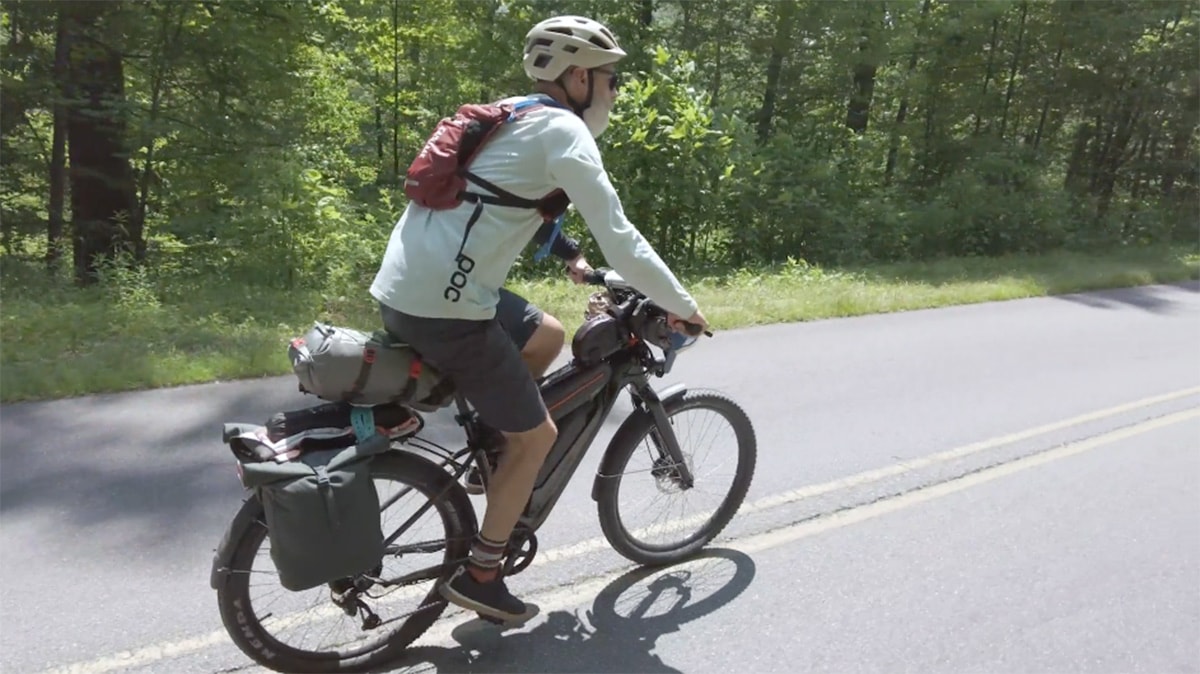
It’s an empty apology and my friends know it. We’re at the beginning of a three-day bikepacking trip through Pisgah National Forest, connecting roughly 90 miles of greenways, gravel forest roads and the world-famous Blue Ridge Parkway to create a massive loop through the Southern Appalachians, beginning and ending at my home in Asheville, North Carolina. I’ve done versions of this bikepacking trip before, but this time I’m on an e-bike.
For the last few months, I’ve been riding an Adventure Neo Allroad, a Class 2 e-bike by Cannondale with a throttle and top pedal-assist speed of 20 mph. The e-bike has revolutionized my in-town riding and I wondered how it would perform on a multiday trip with big miles. Would the battery be a savior on the climbs? Or would I run out of power in the woods and have to push my bike 10 miles to the nearest plug?
Two friends fly in from Minnesota to join me. They’re both experienced bikepackers but have never ridden in the Southern Appalachians before. It’s fun to see the mountains through their fresh eyes as they ogle the lush, thick canopy of hardwoods and rhododendrons, gawk at the rushing mountain streams and blanch at the steep grades. For a minute, I feel guilty about planning a route with so much climbing—more than 5,000 feet on the first day alone. But it’s impossible to avoid hills around here. It’s one of the reasons I thought the e-bike might shine in this situation. Kicking in the pedal assist during the first brutal climb of the day only confirmed my suspicions: The e-bike is built for multiday bikepacking rides.
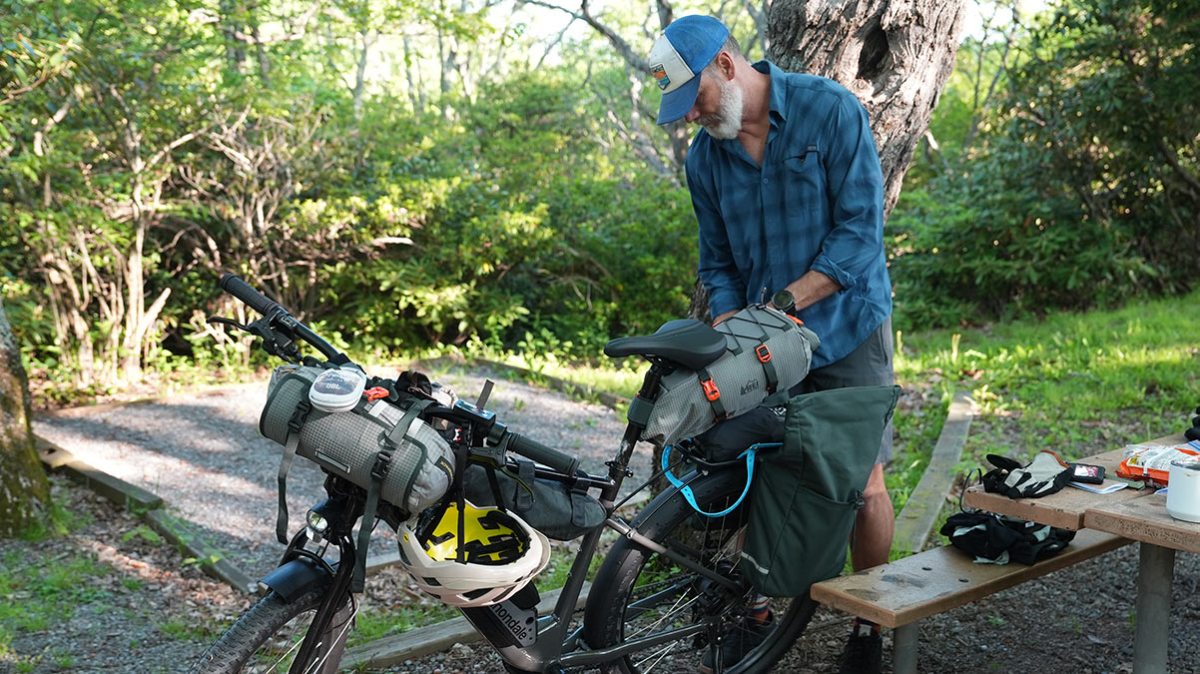
Cutting through Bent Creek Experimental Forest on the western edge of Asheville, the long grade finally delivers us to the Blue Ridge Parkway, a two-lane blacktop that traces mountain ridgelines for 469 miles and connects North Carolina’s Great Smoky Mountains National Park with Virginia’s Shenandoah National Park. The road will take us up to 5,000 feet above sea level to a series of overlooks from which we can look down on green peaks that roll against the horizon. But first, we have to sweat to get these views.
Even though the grade mellows once we hit the parkway, the climbing doesn’t stop. I use the lowest level of pedal assist to conserve the battery and occasionally give my riding partners a boost by placing my hand on their shoulders and pushing them up the hill. That boost seems to brighten their moods and helps them get from one viewpoint to the next in good spirits. In other words, they hate me a little less for my battery-powered shenanigans.
I admit that I had a serious case of “range anxiety” while planning this ride. The battery on my Cannondale Adventure Neo Allroad gets about 40 miles per charge around town, but long climbs can drain the battery faster. Also, my bike is loaded down with food and camping gear; extra weight also cuts into an e-bike’s battery life. From the onset of the ride, I decide only to use the pedal assist when I need it, so I ride with zero assist through town and on the 5 miles of flat greenway. I kill the battery on any long downhills too.
The conservative approach works, and I pull into our campsite after roughly 33 miles and 5,200 feet of climbing with more than half of my battery charge intact. Also, electricity is more readily available than I expected. I’m able to top off my battery at a barbecue restaurant on the edge of Asheville before the real climbing begins. Our campground that night has a bathroom with an outlet, so I can charge it for a few hours while setting up camp and eating dinner. This means I likely won’t have to push my heavy bike and its dead battery on this particular trip, since I have another developed campground reserved for the second night, and my conservative approach to the pedal assist will allow me to knock out each day’s mileage within the battery’s range.
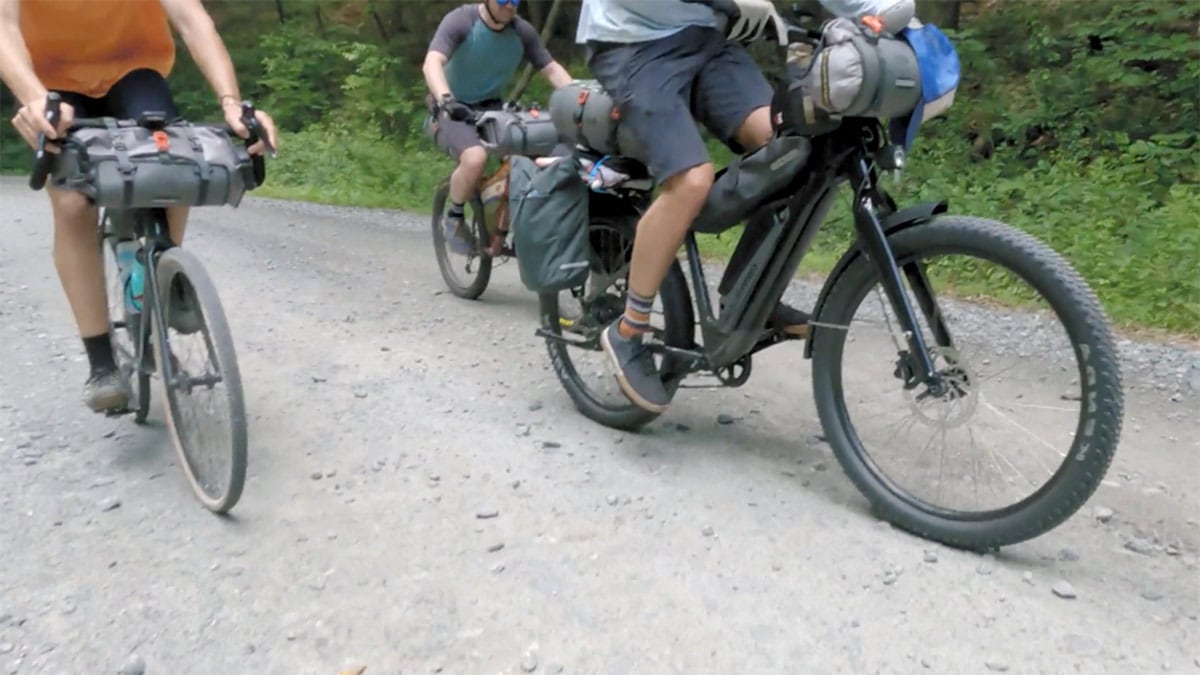
After the range anxiety subsides, the next two days of pedaling are a breeze. We find more gravel to explore and pass tall waterfalls and sliding rocks. We jump from a boulder into a deep pool of crystal-clear water to escape the heat and cook meals by the campfire. It’s exactly like every other bikepacking trip I’ve ever experienced, only I’m not exhausted when I pull into camp each night. I use the pedal assist when I need it on climbs and I show up to camp relatively fresh and downright eager for the next day of riding.
Bikepacking on an e-bike might sound intimidating, but with a little planning, and a conservative approach to the pedal assist, the e-bike can be a handy tool on multiday adventures. What’s more, it opens a whole new world of terrain to cyclists who might not want to suffer for days on end.
8 Tips for a Successful E-Bike Bikepacking Trip
1. Start small
You don’t have to go on an epic journey to the middle of nowhere to have an adventure. In fact, you might not even need to worry about charging your bike if you keep your route to a single night with low mileage. Riding 15 miles into the woods at a casual pace, camping and then riding home the next day is a great introduction to e-bikepacking. Learn more in our series “Intro to Bikepacking.”
2. Plan your campsites around electricity
If you’re hoping to cover long miles over several days, you’ll need to charge your bike along the way. Charging at a restaurant while you eat is possible (make sure you ask first), but you won’t be able to get much juice in the time it takes to eat lunch. Instead, plan on camping where you can plug it in overnight, or at least for a few hours before going to sleep. Most developed campsites will have plugs in the bathrooms that you can use. Some even have sites for RVs with their own dedicated outlets. In a pinch, you can always ask camp hosts for their charging recommendations.
3. Make room for electrical equipment
You still carry all your camping gear on your e-bike when you bikepack, so you need a variety of bags designed to distribute the load throughout your bike. The only difference is that e-bikes typically have a large battery that takes up a significant portion of the frame’s center triangle, making it difficult to use large bags in that space. I used a smaller top-tube bag, which held my tools, some snacks and the charging cord for the bike while leaving plenty of room for the battery itself below the bag. For more advice, read our article on “How to Pack for Bikepacking.”
4. Heavy loads mean less mileage
The more gear you carry, the less mileage you’ll get out of that battery. The same is true for hills: If you’re climbing several thousand feet while carrying 25 pounds of gear, you can expect to cut your mileage in half. Plan your route accordingly.
5. Conserve your battery
It’s tempting to use that pedal assist all the time and fly through the route at a record pace, but you’ll be better served by using pedal assist only when you really need it. Downhills and flat stretches are good places to kill the battery. Also, choosing a low gear with a high cadence on hills will help save the battery. For instance, though the Cannondale Adventure Neo Allroad offers five levels of assist, I always kept it in the lowest pedal-assist mode (1) because it uses the least amount of battery.
6. Mind cycling partners not on e-bikes
If you’re riding with cyclists who aren’t on e-bikes, as I was, keep their effort in mind. Wait for them politely if you zoom ahead up a hill ahead. Better yet, offer an assist by giving them a push on some of the steeper hills. They may not want help, but it’s always nice to ask.
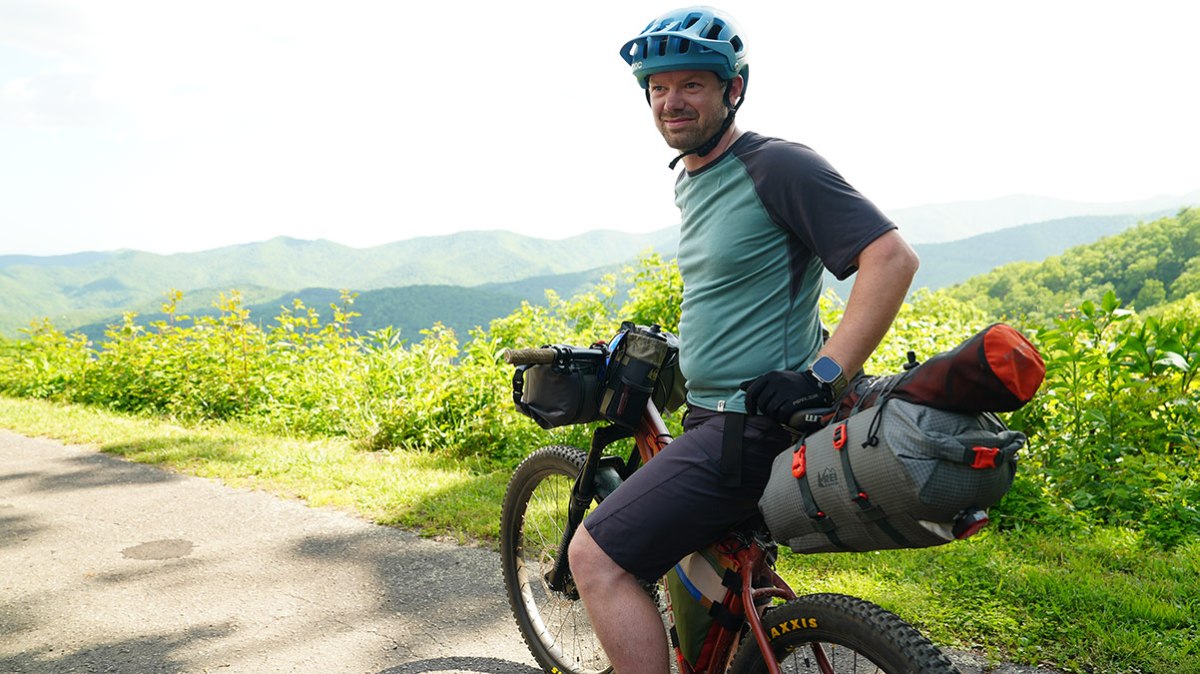
7. Stay on legal routes
Ride your e-bike responsibly. Always check the land manager’s current rules on where your e-bike class can ride. Most national forests don’t allow e-bikes on established trails, so you need to stick to paved and gravel roads and leave the singletrack to the “acoustic” bikes. In the Pisgah National Forest, for example, we stuck to roads and trails designated for motorized use.
For ideas on where to ride, consider resources like PeopleForBikes’ Rides and Routes, and mapping apps like TrailForks.
8. Don’t let range anxiety dissuade you
The estimated range on your handlebar display can be fear-inducing. It’s a good idea to keep the projected daily mileage of your route within that range, but there are ways you can extend the mileage (see above). And there are probably plenty of fun routes that are well within the 20- to 40-mile range of most e-bike batteries.

